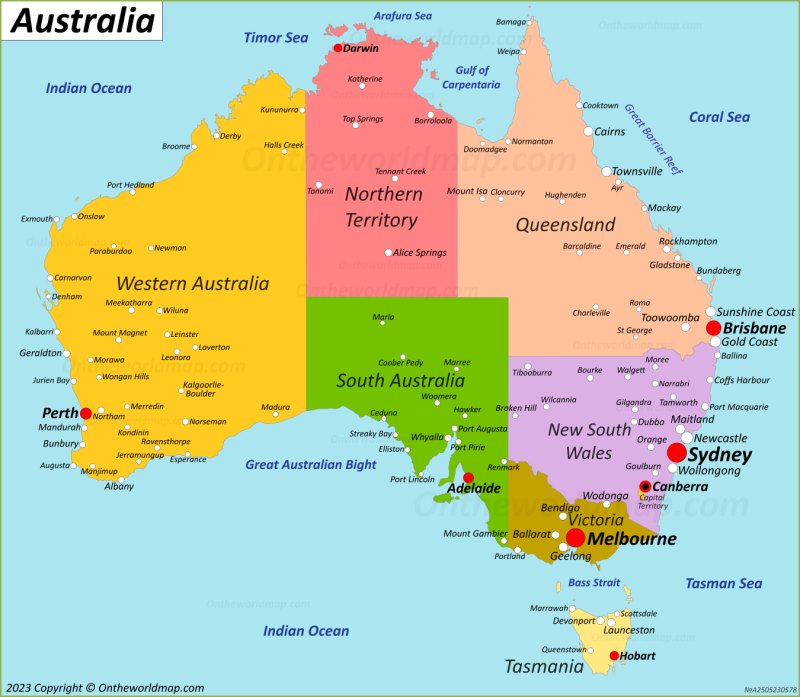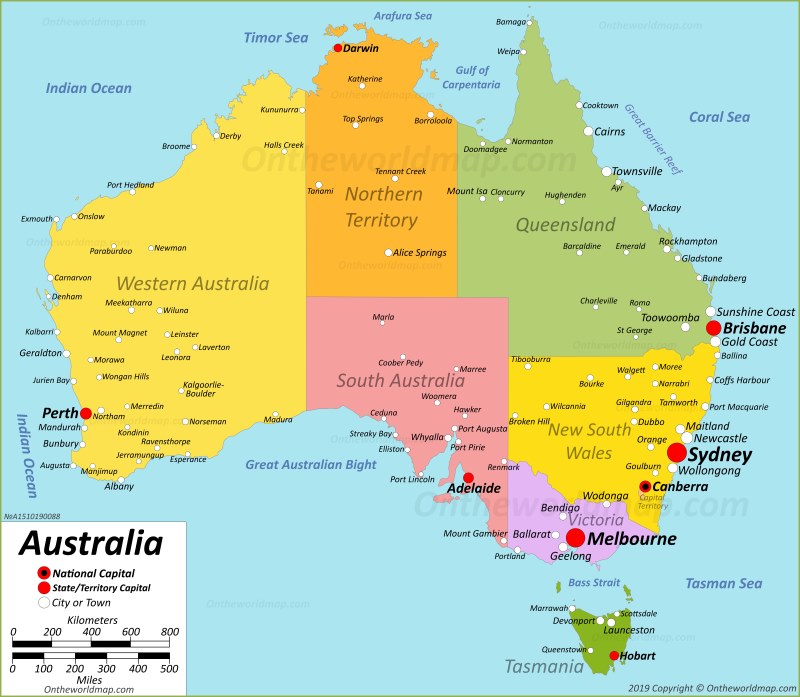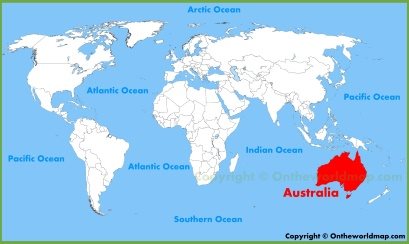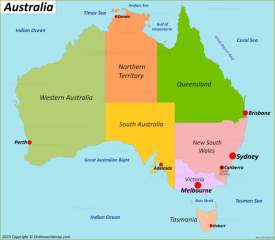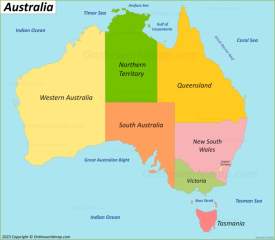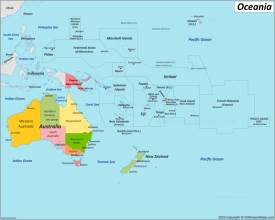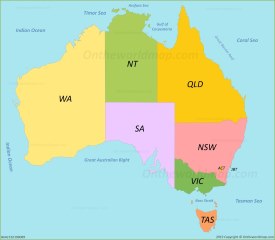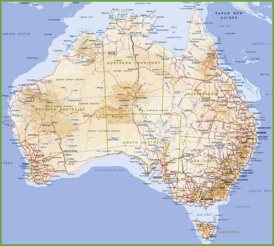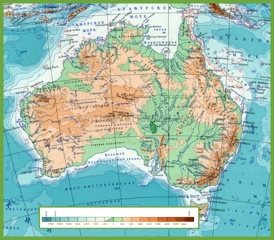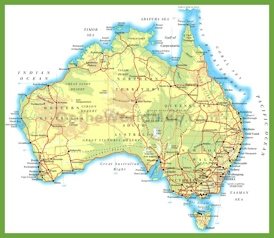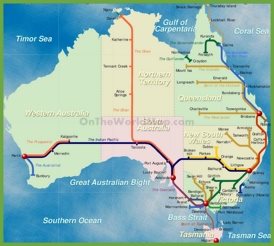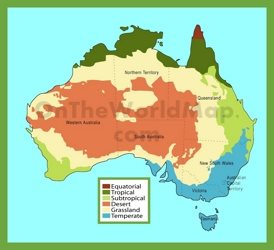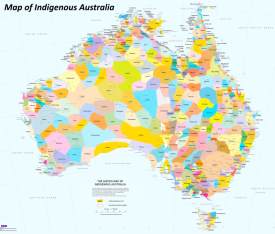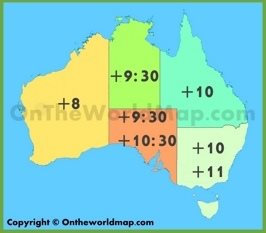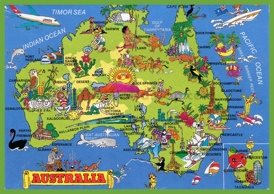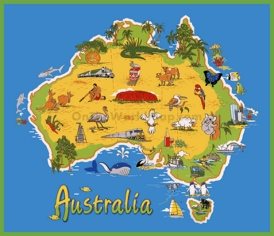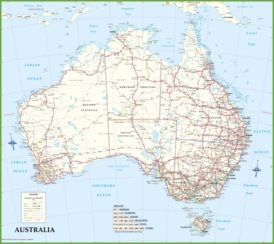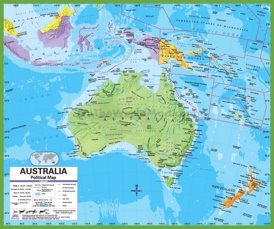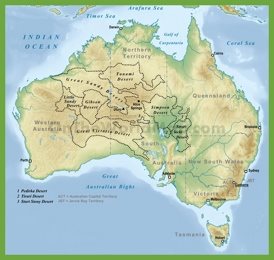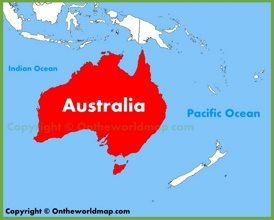Australia Map
Description:
This map shows islands, states and territories, state/territory capitals and major cities and towns in Australia.
Author: Ontheworldmap.com
You may download, print or use the above map for educational, personal and non-commercial purposes. Attribution is required. For any website, blog, scientific research or e-book, you must place a hyperlink (to this page) with an attribution next to the image used.
Description:
This map shows states and territories, state/territory capitals and major cities in Australia.
Author: Ontheworldmap.com
You may download, print or use the above map for educational, personal and non-commercial purposes. Attribution is required. For any website, blog, scientific research or e-book, you must place a hyperlink (to this page) with an attribution next to the image used.
Detailed Maps of Australia
About Australia
Australia, the sixth largest country in the world by area, occupies a unique position in the Southern Hemisphere. It is located between the Indian and Pacific Oceans and has no land borders as it occupies the entire mainland of the Australian continent. The country is made up of six states and two territories and its capital is Canberra.
Canberra, located in the Australian Capital Territory, is the political center, housing the federal government and various national institutions.
Sydney, the largest city, is a major financial and cultural center, known for its famous Sydney Opera House and Harbour Bridge. Melbourne, the second largest city, stands out for its cultural diversity, vibrant arts scene and sporting events. Other significant cities include Brisbane, known for its subtropical climate and proximity to the Gold Coast; Perth, a major economic center in Western Australia; and Adelaide, known for its festivals and wine regions.
Australia's economy is among the largest in the world and is driven by a variety of industries. The country boasts abundant natural resources, including coal, iron ore and natural gas, which contribute significantly to export revenues. In addition, the service sector, especially finance, education and tourism, plays a crucial role in economic growth. Australia maintains strong trade relations with countries such as China, Japan and the United States.
Tourism is a critical component of Australia's economy, attracting millions of visitors each year. The Great Barrier Reef, the world's largest coral reef system, attracts tourists with its unparalleled marine biodiversity. Uluru, a significant cultural attraction for Australia's indigenous people, offers an insight into the country's rich Aboriginal heritage. The Sydney Opera House and Harbour Bridge remain popular attractions symbolizing Australia's modern architectural achievements.
Australia's unique flora and fauna also attracts tourists. Kangaroos, koalas and a variety of bird species highlight the country's distinctive wildlife. National parks such as Kakadu and Daintree provide opportunities for eco-tourism and adventure activities. The country's diverse landscapes, from the outback to pristine beaches, further enhance its appeal as a tourist destination.
The Facts:| Capital: | Canberra |
| Area: | 2,969,907 sq mi (7,692,024 sq km) |
| Population: | ~ 27,000,000 |
| Official language: | None at federal level |
| Religion: | 43.9% Christianity 38.9% no religion 3.2% Islam 2.7% Hinduism 2.4% Buddhism 1.7% other |
| Currency: | Australian dollar ($) (AUD) |
| Driving side: | left |
| Calling code: | +61 |
| Internet TLD: | .au |
| Time zone: | UTC+8; +9.5; +10. Summer (DST) UTC+8; +9.5; +10; +10.5; +11 |
| Official government website: | www.australia.gov.au |
| Official tourism website: | www.australia.com |
Main sights of Australia: Sydney Opera House, Uluru, Great Ocean Road, Great Barrier Reef, Blue Mountains National Park, Fraser Island, Sydney Harbour Bridge, Kangaroo Island, Horizontal Waterfalls, Kakadu National Park.
Google Map of Australia
Largest cities: Sydney, Melbourne, Brisbane, Perth, Adelaide, Gold Coast, Tweed Heads, Newcastle, Maitland, Canberra, Queanbeyan, Sunshine Coast, Wollongong, Geelong, Hobart, Geelong, Cairns, Darwin, Toowoomba, Ballarat, Bendigo, Albury-Wodonga, Launceston, Mackay, Rockhampton, Bunbury, Bundaberg, Coffs Harbour, Hervey Bay, Tamworth, Noosa Heads, Maroochydore, Caloundra.
States And Territories of Australia
States of Australia
| State | Abbreviation | Capital | Population | Area |
|---|---|---|---|---|
| New South Wales | NSW | Sydney | 8,350,000 | 312,724 sq mi (809,952 sq km) |
| Victoria | VIC | Melbourne | 6,850,000 | 91,760 sq mi (237,657 sq km) |
| Queensland | QLD | Brisbane | 5,500,000 | 714,959 sq mi (1,851,736 sq km) |
| Western Australia | WA | Perth | 2,900,000 | 975,685 sq mi (2,527,013 sq km) |
| South Australia | SA | Adelaide | 1,880,000 | 403,227 sq mi (1,044,353 sq km) |
| Tasmania | TAS | Hobart | 575,000 | 35,042 sq mi (90,758 sq km) |
Internal Territories of Australia
| Territory | Abbreviation | Capital | Population | Area |
|---|---|---|---|---|
| Australian Capital Territory | ACT | Canberra | 475,000 | 910 sq mi (2,358 sq km) |
| Northern Territory | NT | Darwin | 255,000 | 548,120 sq mi (1,419,630 sq km) |
| Jervis Bay Territory | NSW | None | 450 | 26 sq mi (68 sq km) |
External territories of Australia: Norfolk Island, Christmas Island, Cocos (Keeling) Islands, Australian Antarctic Territory, Coral Sea Islands, Ashmore and Cartier Islands, Heard Island and McDonald Islands.
Geography of Australia
Australia, the world's smallest continent and largest island, is characterized by a variety of geographical features and climatic conditions. The continent is divided into several distinct regions: the Eastern Highlands, the Central Lowlands, and the Western Plateau.
The Eastern Highlands, also known as the Great Dividing Range, runs along the east coast and contains Australia's highest peak, Mount Kosciuszko. The Central Lowlands, characterized by extensive plains and river systems, lie between the Eastern Highlands and the Western Plateau. The Western Plateau, which covers most of Western Australia, consists of arid deserts and ancient rock formations
Australia's climate varies considerably by region. The northern part of the country has a tropical climate with distinct wet and dry seasons. The wet season, from November to April, brings abundant rainfall and high humidity, while the dry season, from May to October, is characterized by cooler temperatures and minimal rainfall. Arid and semi-arid conditions prevail in the central and western parts of the continent, dominated by deserts such as the Simpson and Great Victoria.
The southern coastal areas have a temperate climate with mild, wet winters and warm, dry summers. Agriculture, including viticulture and dairy farming, is well developed in this region. The east coast, particularly around Sydney and Brisbane, has a humid subtropical climate characterized by warm, wet summers and mild winters.
Overall, Australia's geographic diversity and varied climate influence its ecosystems, agriculture and human settlement patterns, making the continent unique in its ecological and cultural significance.
Nearby Countries: New Zealand, Indonesia, Timor-Leste (East Timor), Papua New Guinea, Solomon Islands, Vanuatu, New Caledonia.
Seas and Oceans: Indian Ocean, Pacific Ocean, Southern Ocean, Arafura Sea, Timor Sea, Great Australian Bight, Tasman Sea, Coral Sea,.
Major Rivers: Murray, Murrumbidgee, Darling, Lachlan, Warrego, Cooper, Paroo, Victoria, Flinders, South Esk, Goulburn, Gascoyne.
Lakes of Australia: Lake Mackay, Lake Sylvester, Tarrabool Lake, Peery Lake, Budgewoi Lake, Narrabeen Lagoon, Avoca Lake, Blue Lake, Lake Woods, Lake Amadeus, Lake Eacham, Lake Galilee, Lake Buchanan, Coongie Lakes, Kati Thanda–Lake Eyre, Lake Torrens, Lake Frome, Lake Alexandrina, Lake Callabonna, Great Lake, Lake St Clair, Lake Corangamite, Lake Hindmarsh, Lake Carnegie, Lake Barlee, Lake Macleod, Lake Way, Lake Burnside.
Mountain Ranges: Australian Alps, Brindabella Range, Allyn Range, Blue Mountains, Budawang Range, Moonbi Range, Ramshead Range, Warrumbungles, Musgrave Ranges, Wellington Range, Bellenden Ker Range, Bunya Mountains, Carnarvon Range, Gillies Range, Barossa Range, Flinders Ranges, Gammon Ranges, Gawler Ranges, Arthur Range, Du Cane Range, Eldon Range, Prince of Wales Range, Tyndall Range, West Coast Range, Cathedral Range, Great Dividing Range, Victorian Alps.
Mountains (Height): Mount Kosciuszko (2228m), Mount Bogong (1986m), Mount Buller (1805m), Mount Ossa (1617m), Mount Bartle Frere (1611m), Brumlow Top (1586m), Round Mountain (1584m), Bellenden Ker (1582m), Legges Tor (1573m), Mount Zeil (1531m), Mount Kaputar (1510m), Frenchmans Cap (1446m), Mount Field West (1435m), Ngarutjaranya (1435m), Mount Anne (1423m), Mount Barrow (1414m), Snowy South (1398m), Mount Carbine Tableland (1383m), Thornton Peak (1374m), Mount Superbus (1371m), Mount Barney (1359m), Mount Weld (1345m), Mount Picton (1327m), Mount Murchison (1278m), Mount William (1259m).
Islands of Australia: Tasmania, Melville Island, Kangaroo Island, Groote Eylandt, Bathurst Island, K'gari, Flinders Island, King Island, Mornington Island, Lord Howe Island, Fraser Island, Great Keppel Island, Whitehaven Beach, Macquarie Island, King Island, Rottnest Island.
Ski Resorts in Australia: Thredbo, Perisher, Selwyn Snow Resort, Charlotte Pass, Mount Hotham, Falls Creek, Mount Baw Baw, Mount Buller, Ben Lomond, Mount Mawson.
The Best Coastal Towns and Cities in Australia: Gold Coast, Byron Bay, Jervis Bay, Port Douglas, Burleigh Heads, Port Macquarie, Apollo Bay, Nelson Bay, Kangaroo Island, Broome, Lorne, Pacific Palms, Cape Tribulation, Yamba, Bicheno, Port Douglas, Yallingup Beach, Avoca Beach, Mollymook, Airlie Beach.
Brief History of Australia
Australia's history reflects a mixture of indigenous cultures and European colonization. Australia's indigenous people, including Aboriginal and Torres Strait Islander peoples, inhabited the continent for more than 65,000 years, developing diverse cultures, languages and traditions deeply connected to the land.
European exploration began in the 17th century when Dutch navigators mapped part of the coast. In 1770, British explorer Captain James Cook captured the east coast of Great Britain, naming it New South Wales. In 1788, the British established the first penal colony at Port Jackson (now Sydney), marking the beginning of European settlement.
Throughout the 19th century, Australia was transformed with the arrival of free settlers and the discovery of gold, fueling economic growth and population growth. The six British colonies - New South Wales, Victoria, Queensland, South Australia, Western Australia and Tasmania - gradually gained self-government.
In 1901, the colonies united to form the Commonwealth of Australia, creating a federal parliamentary democracy. The country participated in both World Wars, strengthening its international presence. Post-war immigration policies diversified the population, fostering a multicultural society.
Today, Australia continues to reconcile its colonial past with its indigenous heritage, striving for social and cultural inclusiveness.

